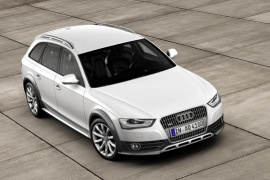
AUDI A4 Allroad
Generations Timeline, Specs and Pictures

Spawning from the successful Audi A6 Allroad, the smaller A4 Allroad has failed to conquer as many customers as its bigger brother, but has managed to create a niche of its own.
The model’s second generation received a mid-cycle facelift in 2019, alongside the regular A4 Avant and A4 sedan. Most of the modifications revolve around an upgraded exterior design and a revamped engine lineup.
Just like its predecessors, the 2019 Audi A4 Allroad differs from the regular A4 Avant thanks to distinct front and rear bumpers, wider wheel arch trims and side sills in gray, along with silver underbody protection and raised roof rails and higher ground clearance. In fact, the ground clearance is 35 mm (1.4 in) higher thanks to larger wheels wheels and slightly raised suspension. This doesn’t exactly make it an SUV but the model is definitely better fit for unpaved roads in this configuration. Only a 2.0 TFSI engine with 245 horsepower is available at the start of production, paired with a seven-speed S Tronic transmission, with two diesel versions to follow.

In 2011, Audi introduced a facelift for the entire A4 range, which included improvements in more areas, not just outside.
A crossover built on the base of a station-wagon was not a new idea. Audi used it before on the A6 Allroad Quattro, and AMC did that in 1987 for the Eagle model. While some were nice additions on the market and were really useful if the owner had a lodge in the mountains, others were just sidewalk crawlers and mall-roaders. The A4 Allroad Quattro was too big to pass as a compact station wagon and too small to be useful in the mountains, but it was a good all-around vehicle.
With its higher ground clearance, the Allroad version tried to make a good impression on the Audi stand at the 2011 Frankfurt Motorshow. Its new headlights with the slim daytime running lights strips and the silver, single-frame grille at the front screamed for attention. The carmaker installed a new set of underbody protections, but since they were made out of plastic, those were there mostly for their look.
Inside, Audi offered a wide selection of steering wheels with chrome and high-gloss inlays. The MMI (multimedia interface) featured only four buttons instead of eight as before, and seven speakers for the standard version. Fortunately, the carmaker left the volume knob in place, still between the front seats.
The German carmaker improved the car on the technical side, with a new electromechanical power steering. For the V6 engined version, the A4 Allroad featured a sport rear differential on the options list.

Audi scored a big success with the A6 Allroad back in 1999, and the management thought that it might get the same result with a smaller brother, the A4 Allroad.
In 2009, the German carmaker introduced the A4 Allroad on the market. It was, basically, an A4 on stilts. The station-wagon already had an all-wheel-drive system. All it needed to become a compact crossover was higher ground clearance. At least, that’s what the marketing department thought. The engineers started to work, the design team enhanced the car’s look, and the result was not as good as expected.
Apart from the basic bodywork of an A4 Avant (that’s Audi’s designation for station-wagons), the Allroad version featured plastic moldings on the wheel arches, side sills, and lower bumpers. They were colored either gray or dark gray, depending on the vehicle’s color. A set of aluminum roof-rails was fitted as standard. In the back, a small roof-spoiler enhanced the look of the rear end, together with a plastic skid plate under the bumper.
Inside, it was just a regular Audi A4 Avant. The instrument cluster was extended over the center console and included the infotainment screen. It was curved toward the driver to amplify the driving sensations. A mix of aluminum, leather, and wood-trims enhanced the car’s interior look. Between the tachometer and speedometer, Audi installed a small TFT screen for the on-board computer.
Under the hood, the Germans planted a choice of five engines paired either with a 6-speed manual or a 7-speed automatic (dual-clutch).























































